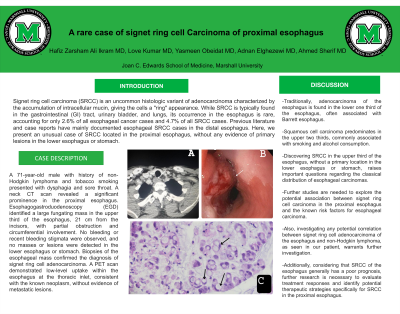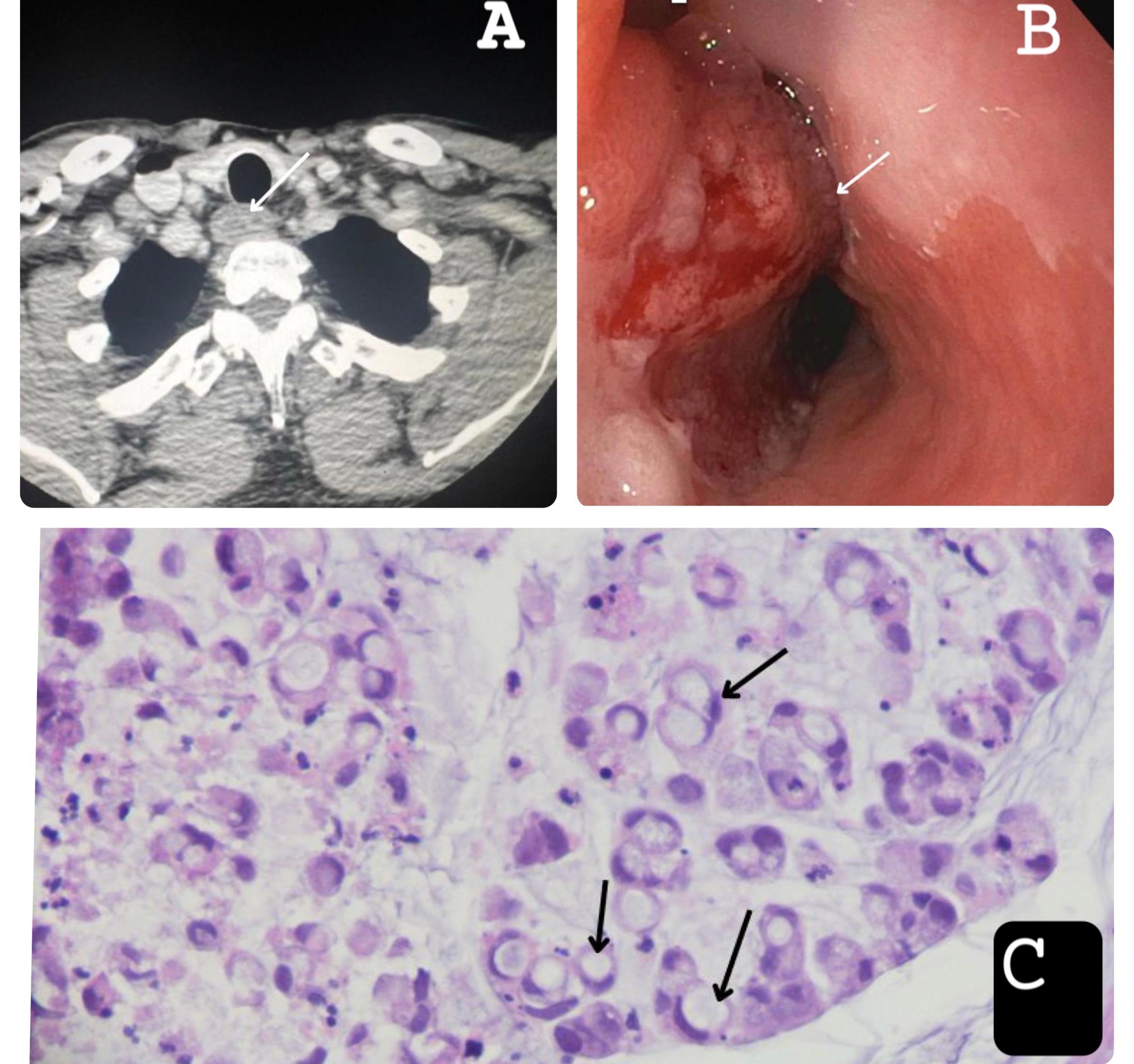Sunday Poster Session
Category: Esophagus
P0451 - A Rare Case of Signet Ring Cell Carcinoma of Proximal Esophagus
Sunday, October 22, 2023
3:30 PM - 7:00 PM PT
Location: Exhibit Hall

Has Audio
- HI
Hafiz Zarsham Ali Ikram, MD
Marshall University School of Medicine
Huntington, West Virginia
Presenting Author(s)
Hafiz Zarsham Ali Ikram, MD1, Love Kumar, MD1, Adnan Elghezewi, MD2, Yasmeen Obeidat, MD3, Ahmed Sherif, MD3
1Marshall University School of Medicine, Huntington, WV; 2Marshall University Joan C. Edwards School of Medicine, Huntington, WV; 3Marshall University, Huntington, WV
Introduction: Signet ring cell carcinoma (SRCC) is an uncommon histologic variant of adenocarcinoma characterized by the accumulation of intracellular mucin, giving the cells a "ring" appearance. While SRCC is typically found in the gastrointestinal (GI) tract, urinary bladder, and lungs, its occurrence in the esophagus is rare, accounting for only 2.6% of all esophageal cancer cases and 4.7% of all SRCC cases. Previous literature and case reports have mainly documented esophageal SRCC cases in the distal esophagus. Here, we present an unusual case of SRCC located in the proximal esophagus, without any evidence of primary lesions in the lower esophagus or stomach.
Case Description/Methods: A 71-year-old male with history of non-Hodgkin lymphoma and tobacco smoking presented with dysphagia and sore throat. A neck CT scan revealed a significant prominence in the proximal esophagus. Esophagogastroduodenoscopy (EGD) identified a large fungating mass in the upper third of the esophagus, 21 cm from the incisors, with partial obstruction and circumferential involvement. No bleeding or recent bleeding stigmata were observed, and no masses or lesions were detected in the lower esophagus or stomach. Biopsies of the esophageal mass confirmed the diagnosis of signet ring cell adenocarcinoma. A PET scan demonstrated low-level uptake within the esophagus at the thoracic inlet, consistent with the known neoplasm, without evidence of metastatic lesions.
Discussion: Traditionally, adenocarcinoma of the esophagus is found in the lower one third of the esophagus, often associated with Barrett esophagus. Squamous cell carcinoma predominates in the upper two thirds, commonly associated with smoking and alcohol consumption. Discovering SRCC in the upper third of the esophagus, without a primary location in the lower esophagus or stomach, raises important questions regarding the classical distribution of esophageal carcinomas. Further studies are needed to explore the potential association between signet ring cell carcinoma in the proximal esophagus and the known risk factors for esophageal carcinoma. Also, investigating any potential correlation between signet ring cell adenocarcinoma of the esophagus and non-Hodgkin lymphoma, as seen in our patient, warrants further investigation. Additionally, considering that SRCC of the esophagus generally has a poor prognosis, further research is necessary to evaluate treatment responses and identify potential therapeutic strategies specifically for SRCC in the proximal esophagus.

Disclosures:
Hafiz Zarsham Ali Ikram, MD1, Love Kumar, MD1, Adnan Elghezewi, MD2, Yasmeen Obeidat, MD3, Ahmed Sherif, MD3. P0451 - A Rare Case of Signet Ring Cell Carcinoma of Proximal Esophagus, ACG 2023 Annual Scientific Meeting Abstracts. Vancouver, BC, Canada: American College of Gastroenterology.
1Marshall University School of Medicine, Huntington, WV; 2Marshall University Joan C. Edwards School of Medicine, Huntington, WV; 3Marshall University, Huntington, WV
Introduction: Signet ring cell carcinoma (SRCC) is an uncommon histologic variant of adenocarcinoma characterized by the accumulation of intracellular mucin, giving the cells a "ring" appearance. While SRCC is typically found in the gastrointestinal (GI) tract, urinary bladder, and lungs, its occurrence in the esophagus is rare, accounting for only 2.6% of all esophageal cancer cases and 4.7% of all SRCC cases. Previous literature and case reports have mainly documented esophageal SRCC cases in the distal esophagus. Here, we present an unusual case of SRCC located in the proximal esophagus, without any evidence of primary lesions in the lower esophagus or stomach.
Case Description/Methods: A 71-year-old male with history of non-Hodgkin lymphoma and tobacco smoking presented with dysphagia and sore throat. A neck CT scan revealed a significant prominence in the proximal esophagus. Esophagogastroduodenoscopy (EGD) identified a large fungating mass in the upper third of the esophagus, 21 cm from the incisors, with partial obstruction and circumferential involvement. No bleeding or recent bleeding stigmata were observed, and no masses or lesions were detected in the lower esophagus or stomach. Biopsies of the esophageal mass confirmed the diagnosis of signet ring cell adenocarcinoma. A PET scan demonstrated low-level uptake within the esophagus at the thoracic inlet, consistent with the known neoplasm, without evidence of metastatic lesions.
Discussion: Traditionally, adenocarcinoma of the esophagus is found in the lower one third of the esophagus, often associated with Barrett esophagus. Squamous cell carcinoma predominates in the upper two thirds, commonly associated with smoking and alcohol consumption. Discovering SRCC in the upper third of the esophagus, without a primary location in the lower esophagus or stomach, raises important questions regarding the classical distribution of esophageal carcinomas. Further studies are needed to explore the potential association between signet ring cell carcinoma in the proximal esophagus and the known risk factors for esophageal carcinoma. Also, investigating any potential correlation between signet ring cell adenocarcinoma of the esophagus and non-Hodgkin lymphoma, as seen in our patient, warrants further investigation. Additionally, considering that SRCC of the esophagus generally has a poor prognosis, further research is necessary to evaluate treatment responses and identify potential therapeutic strategies specifically for SRCC in the proximal esophagus.

Figure: Image A: CT neck showing proximal esophagus prominence.
Image B: Large fungating mass in proximal esophagus seen on EGD.
Image C: Biopsy of proximal esophageal mass specimen showing signet ring cells
Image B: Large fungating mass in proximal esophagus seen on EGD.
Image C: Biopsy of proximal esophageal mass specimen showing signet ring cells
Disclosures:
Hafiz Zarsham Ali Ikram indicated no relevant financial relationships.
Love Kumar indicated no relevant financial relationships.
Adnan Elghezewi indicated no relevant financial relationships.
Yasmeen Obeidat indicated no relevant financial relationships.
Ahmed Sherif indicated no relevant financial relationships.
Hafiz Zarsham Ali Ikram, MD1, Love Kumar, MD1, Adnan Elghezewi, MD2, Yasmeen Obeidat, MD3, Ahmed Sherif, MD3. P0451 - A Rare Case of Signet Ring Cell Carcinoma of Proximal Esophagus, ACG 2023 Annual Scientific Meeting Abstracts. Vancouver, BC, Canada: American College of Gastroenterology.
